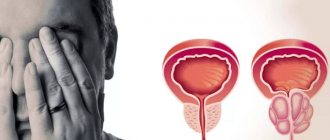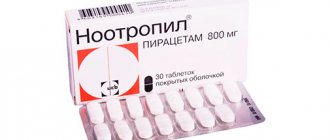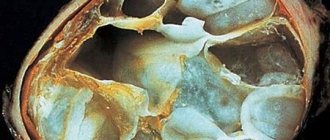pharmachologic effect
Serotonin 5-HT1 receptor agonist. A drug with antimigraine activity.
Pharmacokinetics
After oral administration, it is quickly absorbed. 70% of the maximum plasma concentration is achieved after 45 minutes. Cmax in blood plasma is 54 ng/ml. Bioavailability - 14% (due to first-pass metabolism and incomplete absorption). Plasma protein binding is 14-21%.
Metabolized by oxidation with the participation of monoaminoxylase (mainly isoenzyme A) with the formation of metabolites, the main of which are the indoleacetic analogue of sumatriptan, which does not have pharmacological activity against 5-HT1-serotonin receptors, and its glucuronide. It is excreted by the kidneys, mainly in the form of metabolites.
Pharmacodynamics
Sumatriptan is a specific selective agonist of 5-HT1-serotonin receptors, localized primarily in the blood vessels of the brain and their stimulation leads to a narrowing of these vessels. Does not affect other subtypes of 5-HT-serotonin receptors (5-HT2-7). Activates the sensitivity of trigeminal nerve receptors. The therapeutic effect usually occurs 30 minutes after administration.
Reception and dosage
It is recommended to start taking the drug at the first manifestations of a migraine attack.
is not used for the same migraine attack . In such cases, paracetamol, acetylsalicylic acid or NSAIDs can be used to relieve an attack.
However, sumatriptan can be used to relieve subsequent migraine attacks . If the patient feels improved after the first dose and then symptoms return, a second dose may be administered within the next 24 hours, provided that the interval between doses is at least 2 hours.
Pills
Taken orally, the tablet should be swallowed whole with water. Treatment should be started as early as possible when a migraine attack occurs.
The recommended dose is 50 mg, if necessary - 100 mg. The maximum daily dose is 300 mg.
Nasal spray
This dosage form is especially indicated for migraine attacks accompanied by nausea and vomiting in children over 12 years of age, as well as for achieving an immediate clinical effect. The spray is equally effective when used at any stage of a migraine attack.
Use intranasally. The recommended dose of the drug for adults is 20 mg per nasal passage; for children 12-18 years old - 10 mg per nasal passage.
Contraindications to the use of Sumatriptan
- hemiplegic, basilar or ophthalmoplegic forms of migraine;
- IHD or the presence of symptoms suggesting its presence;
- history of myocardial infarction;
- pharmacologically uncontrolled arterial hypertension;
- occlusive diseases of peripheral vessels;
- stroke or transient cerebrovascular accident (including history);
- severe dysfunction of the liver and kidneys;
- simultaneous use with ergotamine or its derivatives and within 24 hours after their administration;
- use while taking monoamine oxidase inhibitors or earlier than 2 weeks after discontinuation of these drugs;
- age under 18 and over 65 years (efficacy and safety have not been established);
- pregnancy;
- breastfeeding (breastfeeding is possible no earlier than 24 hours after taking the drug;
- congenital galactosemia, glucose/galactose malabsorption syndrome, congenital lactose deficiency;
- hypersensitivity to any of the components of the drug.
With caution: epilepsy (including any conditions with a reduced epileptic threshold), pharmacologically controlled arterial hypertension, impaired liver or kidney function, hypersensitivity to sulfonamides (administration of sumatriptan can cause allergic reactions, the severity of which varies from skin manifestations to anaphylaxis) .
SUMATRIPTAN
Side effects
Classification of the incidence of side effects according to the recommendations
of the World Health Organization (WHO):
very often >1/10;
often from > 1/100 to < 1/10;
infrequently from > 1/100 to < 1/100;
rarely from > 1/10000 to < 1/1000;
very rarely <1/10000, including isolated reports;
frequency unknown - based on available data, it is not possible to determine the frequency of occurrence.
Nervous system disorders:
often - dizziness, drowsiness, sensory disturbances, including paresthesia and decreased sensitivity;
frequency unknown - seizures (in some cases observed in patients with a history of seizures or with concomitant conditions predisposing to seizures; in some patients no risk factors were identified), tremor, dystopia, nystagmus, scotoma, anxiety.
Cardiovascular system disorders:
often - a transient increase in blood pressure (shortly after taking the drug), hot flashes;
frequency unknown - bradycardia, tachycardia, arrhythmias, signs of transient ischemia on the ECG, coronary vasospasm, angina pectoris, myocardial infarction, decreased blood pressure, Raynaud's syndrome.
Disorders of the respiratory system, chest and mediastinal organs:
often - shortness of breath, mild transient irritation of the mucous membrane or burning sensation
in the nasal cavity or throat, nosebleeds.
Gastrointestinal disorders:
often - nausea, vomiting (cause-and-effect relationship has not been proven);
very rarely - ischemic colitis, dysphagia, abdominal discomfort, diarrhea.
Musculoskeletal and connective tissue disorders:
often - a feeling of heaviness (usually transient, can be intense and occur
any part of the body, including the chest and throat);
frequency unknown - stiff neck, arthralgia.
Visual disorders:
frequency unknown - flickering, diplopia, decreased visual acuity, loss of vision (usually transient); however, visual disturbances may be caused by the migraine attack itself.
Immune system disorders:
frequency unknown - hypersensitivity reactions, including skin manifestations,
as well as anaphylaxis.
Laboratory indicators:
very rarely - minor deviations in liver test results.
Common disorders:
often - pain, a feeling of cold or heat, a feeling of pressure or tightness (usually transient, can be intense and occur in any part of the body, including the chest and throat), weakness, fatigue (usually transient, mild or moderate expression); frequency unknown - hyperhidrosis.
Side effects
The frequency of adverse reactions listed below was determined according to the following: very often - more than 1/10; often - from more than 1/100 to less than 1/10; sometimes - from more than 1/1000 to less than 1/100; rarely - from more than 1/10,000 to less than 1/1000; very rarely - from less than 1/10,000, including isolated cases.
From the nervous system: often - dizziness, drowsiness, sensory disturbances, including parasthesia and decreased sensitivity.
From the cardiovascular system: often - a transient increase in blood pressure (observed soon after taking the drug), "hot flashes".
From the respiratory system and organs of the cell group: often - dyspnea, mild, transient irritation of the mucous membrane or a burning sensation in the nasal cavity or throat, nosebleeds.
From the gastrointestinal tract: often - nausea, vomiting.
From the musculoskeletal system and connective tissue: often - a feeling of heaviness (usually transient, can be intense and occur in any part of the body, including the chest and throat).
General and local reactions: often - pain, a feeling of cold or heat, a feeling of pressure or tightness (usually transient, can be intense and occur in any part of the body, including the chest and throat), weakness, fatigue (usually mild or moderate, transitory).
Laboratory indicators: very rarely - minor deviations in liver test results.
Post-marketing surveillance
From the immune system: very rarely - hypersensitivity reactions, including skin manifestations, as well as anaphylaxis.
From the nervous system: very rarely - seizures (in some cases observed in patients with a history of seizures or with concomitant conditions predisposing to seizures; in some patients no risk factors were identified), tremor, dystonia, nystagmus, scotoma.
On the part of the visual organs: very rarely - flickering, diplopia, decreased visual acuity, blindness (usually transient). However, visual disturbances can be caused by the migraine attack itself.
From the cardiovascular system: very rarely - bradycardia, tachycardia, flutter, arrhythmias, transient changes on the ECG, coronary vasospasm, angina pectoris, myocardial infarction, hypotension, Raynaud's syndrome.
From the gastrointestinal tract: very rarely - ischemic colitis, dysphagia, feeling of discomfort in the abdomen.
Sumatriptan, 2 pcs., 100 mg, film-coated tablets
The frequency of adverse reactions listed below was determined according to the following: very often - more than 1/10; often - from more than 1/100 to less than 1/10; sometimes - from more than 1/1000 to less than 1/100; rarely - from more than 1/10,000 to less than 1/1000; very rarely - from less than 1/10,000, including isolated cases.
From the nervous system: often - dizziness, drowsiness, sensory disturbances, including parasthesia and decreased sensitivity.
From the cardiovascular system: often - a transient increase in blood pressure (observed soon after taking the drug), "hot flashes".
From the respiratory system and organs of the cell group: often - dyspnea, mild, transient irritation of the mucous membrane or a burning sensation in the nasal cavity or throat, nosebleeds.
From the gastrointestinal tract: often - nausea, vomiting.
From the musculoskeletal system and connective tissue: often - a feeling of heaviness (usually transient, can be intense and occur in any part of the body, including the chest and throat).
General and local reactions: often - pain, a feeling of cold or heat, a feeling of pressure or tightness (usually transient, can be intense and occur in any part of the body, including the chest and throat), weakness, fatigue (usually mild or moderate, transitory).
Laboratory indicators: very rarely - minor deviations in liver test results.
Post-marketing surveillance
From the immune system: very rarely - hypersensitivity reactions, including skin manifestations, as well as anaphylaxis.
From the nervous system: very rarely - seizures (in some cases observed in patients with a history of seizures or with concomitant conditions predisposing to seizures; in some patients no risk factors were identified), tremor, dystonia, nystagmus, scotoma.
On the part of the visual organs: very rarely - flickering, diplopia, decreased visual acuity, blindness (usually transient). However, visual disturbances can be caused by the migraine attack itself.
From the cardiovascular system: very rarely - bradycardia, tachycardia, flutter, arrhythmias, transient changes on the ECG, coronary vasospasm, angina pectoris, myocardial infarction, hypotension, Raynaud's syndrome.
From the gastrointestinal tract: very rarely - ischemic colitis, dysphagia, feeling of discomfort in the abdomen.
Drug interactions
When administered simultaneously with ergotamine and ergotamine-containing drugs, prolonged vasospasm is possible.
Possible interaction between sumatriptan and MAO inhibitors (decreased metabolism of sumatriptan, increased its concentration).
With the simultaneous use of sumatriptan and drugs from the group of selective serotonin reuptake inhibitors, the development of weakness, hyperreflexia and impaired coordination of movements is possible.
There was no interaction of sumatriptan with propranolol, flunirizine, pizotifen and ethanol.
Contraindications
- Hypersensitivity,
- hemiplegic, basilar or ophthalmoplegic form of migraine,
- myocardial infarction (including history),
- uncontrolled arterial hypertension, coronary artery disease (including suspicion of it), angina pectoris, incl. Prinzmetal's angina, occlusive diseases of peripheral vessels,
- transient cerebrovascular accident (including a history), stroke (including a history),
- severe impairment of liver and/or kidney function,
- simultaneous use of sumatriptan with other serotonergic drugs (ergotamine, metisegride, triptans) and monoamine oxidase inhibitors.
Sumatriptan is not used to prevent migraine attacks!
Sumatriptan dosage
Inside, the tablet should be swallowed whole with water. Treatment should be started as early as possible when a migraine attack occurs. The recommended dose is 50 mg, if necessary - 100 mg.
If migraine symptoms do not disappear or decrease after taking the first dose, then the drug should not be used again to relieve the same attack.
To relieve subsequent attacks (if symptoms decrease or disappear and then recur), you can take a second dose within the next 24 hours, provided that the interval between doses is at least 2 hours.
The maximum daily dose is 300 mg.
Directions for use and doses
Orally (swallow the tablet whole with water).
The initial single dose is 50 mg; if necessary, the dose can be increased to 100 mg. If migraine symptoms do not disappear or improve after the first dose, then a second dose is not prescribed to relieve an ongoing attack. To relieve subsequent attacks (if symptoms decrease or disappear and then return), you can take a second dose over the next 24 hours, provided that the interval between doses is at least 2 hours.
The maximum daily dose when taken orally is 300 mg.
Interaction
Concomitant use is contraindicated:
- with ergotamine and ergotamine-containing drugs (prolonged vasospasm is possible, a 24-hour pause between doses is recommended);
- with monoamine oxidase inhibitors;
- with lithium salts (cases of the development of serotonin syndrome have been described);
- with drugs from the group of selective serotonin reuptake inhibitors;
- with other triptans (risk of additive hyperstimulation of serotonin receptors).
There was no interaction of sumatriptan with propranolol, flunarizine, pizotifen, or ethyl alcohol.







